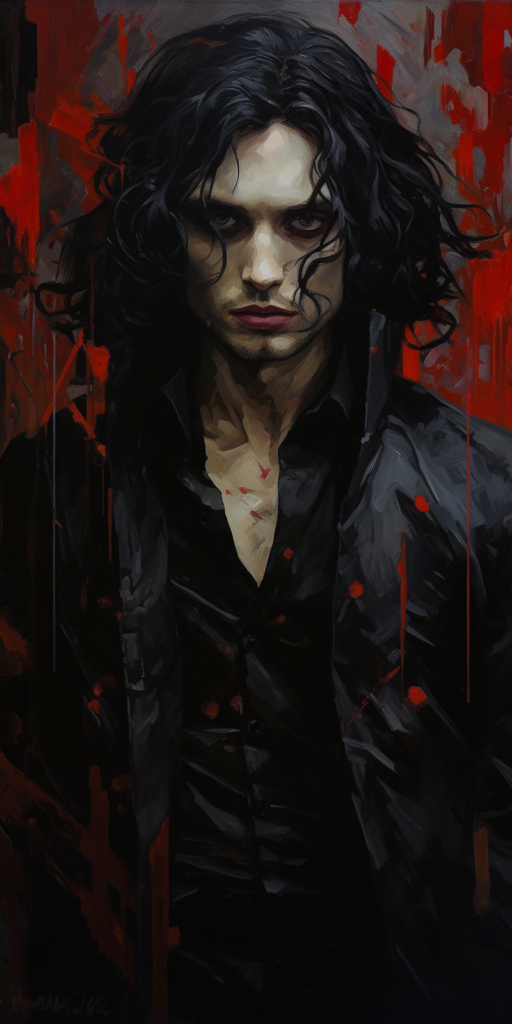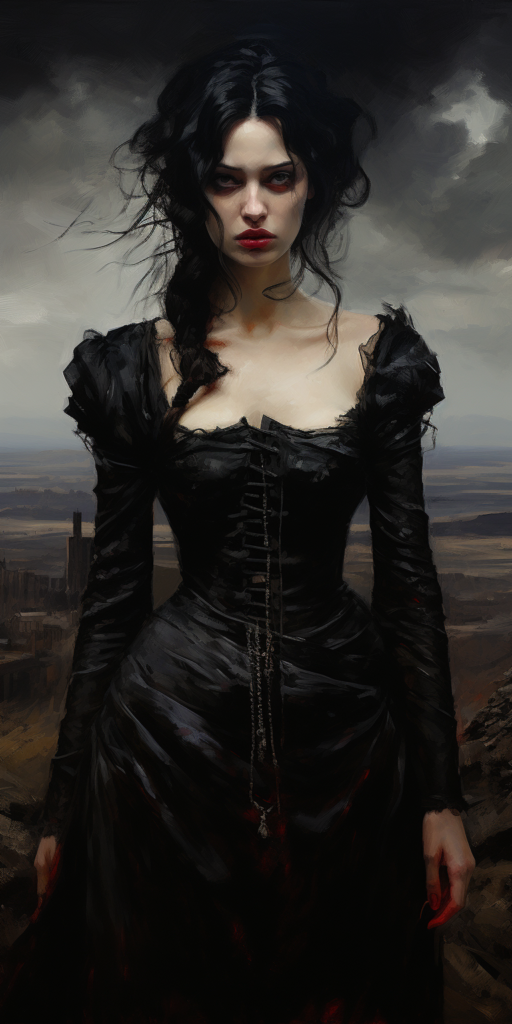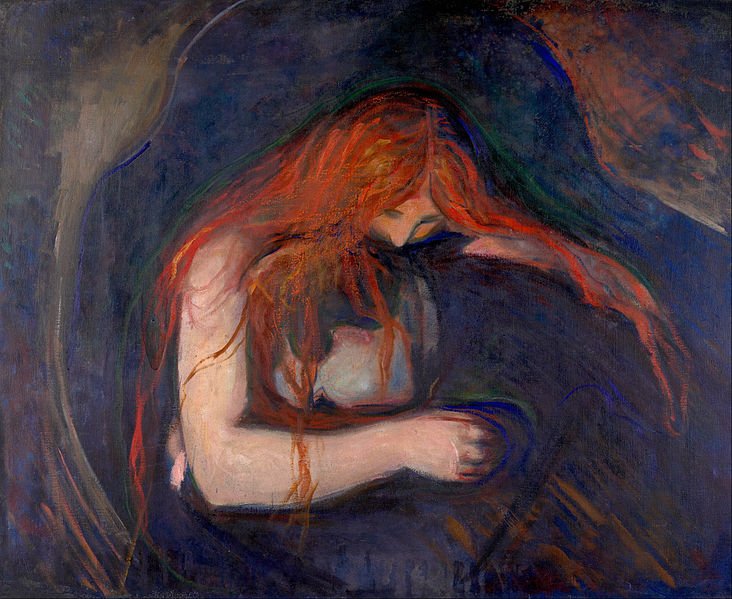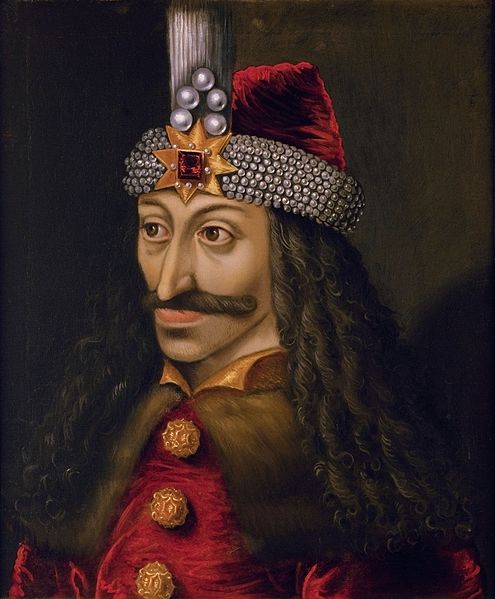Vampire, “The Crimson Dynasty”
Vampires are beings that subsist on human and/or animal lifeforce. They are reanimated corpses who feed by draining and consuming the blood of living beings. The term usually refers to the blood-drinkers of Eastern Europe, but the term is often applied to similar creatures from other regions and cultures.

A vampire is a supernatural creature often depicted as an undead being. They have a human-like appearance, but there are distinctive physical features that set them apart. Vampires are typically described as:
Physical Description:
- Pale Skin: Vampires have extremely pale or even translucent skin, which contrasts with the living.
- Sharp Fangs: They possess elongated, sharp canine teeth, often the upper canines, which they use to puncture their victims’ necks and extract blood.
- Red or Glowing Eyes: Their eyes can sometimes appear red, or they may seem to glow, especially when they’re agitated or hungry.
- Cold Body: Vampires have a body temperature significantly lower than that of living humans.
- Inhuman Beauty: Many vampires are depicted as incredibly attractive individuals, often to the point of mesmerizing their victims.
- Enhanced Strength and Speed: Vampires possess superhuman physical abilities, including great strength and exceptional agility.
- Ability to Transform: Some vampire legends include the ability to transform into creatures like bats or wolves.
- Immortality: They do not age and are effectively immortal unless destroyed.
General Description: Vampires are legendary beings known for their need to feed on the blood of the living. They are often portrayed as nocturnal creatures, sleeping during the day and coming to life at night. Vampires are said to be cursed or damned, with their condition resulting from various origins, including being bitten by another vampire or as a consequence of their own malevolent actions in life.
Vampires have a strong aversion to sunlight, and it can harm or destroy them. They are also known to fear religious symbols, such as crosses and holy water. Garlic is believed to repel them, and they often cannot enter private spaces without an invitation. To feed, vampires must find willing or unwilling victims to drain their blood. This act of feeding not only sustains them but can also create new vampires if the victim does not die.
In many vampire tales, they are tormented by their existence, struggling with their dark desires and the consequences of their actions. Vampire lore has evolved and diversified over the centuries, with each culture contributing its unique variations to the myth of the vampire. These legends continue to captivate and terrify people in modern times, making vampires one of the most enduring and iconic creatures in folklore and popular culture.
Vampire

Family: Vampires
Medium undead (shapechanger), lawful evil
Armor Class 16 (natural armor)
Hit Points 144 (17d8 + 68)
Speed 30 ft.
| STR | DEX | CON | INT | WIS | CHA |
|---|---|---|---|---|---|
| 18 (+4) | 18 (+4) | 18 (+4) | 17 (+3) | 15 (+2) | 18 (+4) |
Saving Throws Dex +9, Wis +7, Cha +9
Skills Perception +7, Stealth +9
Damage Resistances necrotic; bludgeoning, piercing, and slashing from nonmagical attacks
Senses darkvision 120 ft., passive Perception 17
Languages the languages it knew in life
Challenge 13 (10,000 XP)
Special Traits
- Shapechanger: If the vampire isn’t in sunlight or running water, it can use its action to polymorph into a Tiny bat or a Medium cloud of mist, or back into its true form. While in bat form, the vampire can’t speak, its walking speed is 5 feet, and it has a flying speed of 30 feet. Its statistics, other than its size and speed, are unchanged. Anything it is wearing transforms with it, but nothing it is carrying does. It reverts to its true form if it dies. While in mist form, the vampire can’t take any actions, speak, or manipulate objects. It is weightless, has a flying speed of 20 feet, can hover, and can enter a hostile creature’s space and stop there. In addition, if air can pass through a space, the mist can do so without squeezing, and it can’t pass through water. It has advantage on Strength, Dexterity, and Constitution saving throws, and it is immune to all nonmagical damage, except the damage it takes from sunlight.
- Legendary Resistance (3/Day): If the vampire fails a saving throw, it can choose to succeed instead.
- Misty Escape: When it drops to 0 hit points outside its resting place, the vampire transforms into a cloud of mist (as in the Shapechanger trait) instead of falling unconscious, provided that it isn’t in sunlight or running water. If it can’t transform, it is destroyed. While it has 0 hit points in mist form, it can’t revert to its vampire form, and it must reach its resting place within 2 hours or be destroyed. Once in its resting place, it reverts to its vampire form. It is then paralyzed until it regains at least 1 hit point. After spending 1 hour in its resting place with 0 hit points, it regains 1 hit point.
- Regeneration: The vampire regains 20 hit points at the start of its turn if it has at least 1 hit point and isn’t in sunlight or running water. If the vampire takes radiant damage or damage from holy water, this trait doesn’t function at the start of the vampire’s next turn.
- Spider Climb: The vampire can climb difficult surfaces, including upside down on ceilings, without needing to make an ability check.
- Vampire Weaknesses: The vampire has the following flaws:
- Forbiddance: The vampire can’t enter a residence without an invitation from one of the occupants.
- Harmed by Running Water: The vampire takes 20 acid damage if it ends its turn in running water.
- Stake to the Heart: If a piercing weapon made of wood is driven into the vampire’s heart while the vampire is incapacitated in its resting place, the vampire is paralyzed until the stake is removed.
- Sunlight Hypersensitivity: The vampire takes 20 radiant damage when it starts its turn in sunlight. While in sunlight, it has disadvantage on attack rolls and ability checks.
Actions
- Multiattack (Vampire Form Only): The vampire makes two attacks, only one of which can be a bite attack.
- Unarmed Strike (Vampire Form Only): Melee Weapon Attack: +9 to hit, reach 5 ft., one creature. Hit: 8 (1d8 + 4) bludgeoning damage. Instead of dealing damage, the vampire can grapple the target (escape DC 18).
- Bite (Bat or Vampire Form Only): Melee Weapon Attack: +9 to hit, reach 5 ft., one willing creature, or a creature that is grappled by the vampire, incapacitated, or restrained. Hit: 7 (1d6 + 4) piercing damage plus 10 (3d6) necrotic damage. The target’s hit point maximum is reduced by an amount equal to the necrotic damage taken, and the vampire regains hit points equal to that amount. The reduction lasts until the target finishes a long rest. The target dies if this effect reduces its hit point maximum to 0. A humanoid slain in this way and then buried in the ground rises the following night as a vampire spawn under the vampire’s control.
- Charm: The vampire targets one humanoid it can see within 30 feet of it. If the target can see the vampire, the target must succeed on a DC 17 Wisdom saving throw against this magic or be charmed by the vampire. The charmed target regards the vampire as a trusted friend to be heeded and protected. Although the target isn’t under the vampire’s control, it takes the vampire’s requests or actions in the most favorable way it can, and it is a willing target for the vampire’s bite attack. Each time the vampire or the vampire’s companions do anything harmful to the target, it can repeat the saving throw, ending the effect on itself on a success. Otherwise, the effect lasts 24 hours or until the vampire is destroyed, is on a different plane of existence than the target or takes a bonus action to end the effect.
- Children of the Night (1/Day): The vampire magically calls 2d4 swarms of bats or rats, provided that the sun isn’t up. While outdoors, the vampire can call 3d6 wolves instead. The called creatures arrive in 1d4 rounds, acting as allies of the vampire and obeying its spoken commands. The beasts remain for 1 hour, until the vampire dies, or until the vampire dismisses them as a bonus action.
Legendary Actions
The vampire can take 3 legendary actions, choosing from the options below. Only one legendary action option can be used at a time and only at the end of another creature’s turn. The vampire regains spent legendary actions at the start of its turn.
- Move: The vampire moves up to its speed without provoking opportunity attacks.
- Unarmed Strike: The vampire makes one unarmed strike.
- Bite (Costs 2 Actions): The vampire makes one bite attack.
About
This alluring, raven-haired beauty casually wipes a trickle of blood from a pale cheek, then smiles to reveal needle-sharp fangs.
CREATING A VAMPIRE

“Vampire” is an acquired template that can be added to any humanoid or monstrous humanoid creature (referred to hereafter as the base creature).
A vampire uses all the base creature’s statistics and special abilities except as noted here.
- Size and Type: The creature’s type changes to undead (augmented humanoid or monstrous humanoid). Do not recalculate base attack bonus, saves, or skill points. Size is unchanged.
- Hit Dice: Increase all current and future Hit Dice to d12s.
- Speed: Same as the base creature.
If the base creature has a Swim speed, the vampire retains the ability to Swim and is not vulnerable to immersion in running water (see below). - Armor Class: The base creature’s natural armor bonus improves by +6.
- Attack: A vampire retains all the attacks of the base creature and also gains a slam attack if it didn’t already have one. If the base creature can use weapons, the vampire retains this ability. A creature with natural weapons retains those natural weapons.
- A vampire fighting without weapons uses either its slam attack or its primary natural weapon (if it has any). A vampire armed with a weapon uses its slam or a weapon, as it desires.
- Full Attack: A vampire fighting without weapons uses either its slam attack (see above) or its natural weapons (if it has any). If armed with a weapon, it usually uses the weapon as its primary attack along with a slam or other natural weapon as a natural secondary attack.
- Damage: Vampires have slam attacks. If the base creature does not have this attack form, use the appropriate damage value from the table below according to the vampire’s size. Creatures that have other kinds of natural weapons retain their old damage values or use the appropriate value from the table below, whichever is better.

| Size | Damage |
| Fine | 1 |
| Diminutive | 1d2 |
| Tiny | 1d3 |
| Small | 1d4 |
| Medium | 1d6 |
| Large | 1d8 |
| Huge | 2d6 |
| Gargantuan | 2d8 |
| Colossal | 4d6 |
- Special Attacks: A vampire retains all the special attacks of the base creature and gains those described below. Saves have a DC of 10 + 1/2 vampire’s
HD + vampire’s Charisma modifier unless noted otherwise. - Blood Drain (Ex): A vampire can suck blood from a living victim with its fangs by making a successful grapple check. If it pins the foe, it drains blood, dealing 1d4 points of Constitution drain each round the pin is maintained. On each such successful attack, the vampire gains 5 temporary hit points.
- Children of the Night (Su): Vampires command the lesser creatures of the world and once per day can call forth 1d6+1 rat swarms, 1d4+1 bat swarms, or a pack of 3d6 wolves as a standard action. (If the base creature is not terrestrial, this power might summon other creatures of similar power.) These creatures arrive in 2d6 rounds and serve the vampire for up to 1 hour.
- Dominate (Su): A vampire can crush an opponent’s will just by looking onto his or her eyes. This is similar to a gaze attack, except that the vampire must use a standard action, and those merely looking at it are not affected. Anyone the vampire targets must succeed on a Will save or fall instantly under the vampire’s influence as though by a dominate person spell (caster level 12th). The ability has a range of 30 feet.
- Create Spawn (Su): A humanoid or monstrous humanoid slain by a vampire’s energy drain rises as a vampire spawn 1d4 days after burial.
- If the vampire instead drains the victim’s Constitution to 0 or lower, the victim returns as a spawn if it had 4 or less HD and as a vampire if it had 5 or more HD. In either case, the new vampire or spawn is under the command of the vampire that created it and remains enslaved until its master’s destruction. At any given time a vampire may have enslaved spawn totaling no more than twice its own Hit Dice; any spawn it creates that would exceed this limit are created as free-willed vampires or vampire spawn. A vampire that is enslaved may create and enslave spawn of its own, so a master vampire can control a number of lesser vampires in this fashion. A vampire may voluntarily free an enslaved spawn in order to enslave a new spawn, but once freed, a vampire or vampire spawn cannot be enslaved again.
- Energy Drain (Su): Living creatures hit by a vampire’s slam attack (or any other natural weapon the vampire might possess) gain two negative levels. For each negative level bestowed, the vampire gains 5 temporary hit points. A vampire can use its energy drain ability once per round.
- Special Qualities: A vampire retains all the special qualities of the base creature and gains those described below.
- Alternate Form (Su): A vampire can assume the shape of a bat, dire bat, wolf, or dire wolf as a standard action. This ability is similar to a polymorph spell cast by a 12th-level character, except that the vampire does not regain hit points for changing form and must choose from among the forms mentioned here. While in its alternate form, the vampire loses its natural slam attack and dominate ability, but it gains the natural weapons and extraordinary special attacks of its new form. It can remain in that form until it assumes another or until the next sunrise. (If the base creature is not terrestrial, this power might allow other forms.)
- Damage Reduction (Su): A vampire has damage reduction 10/silver and magic. A vampire’s natural weapons are treated as magic weapons for the purpose of overcoming damage reduction.
- Fast Healing (Ex): A vampire heals 5 points of damage each round so long as it has at least 1 hit point. If reduced to 0 hit points in combat, it automatically assumes gaseous form and attempts to escape. It must reach its coffin home within 2 hours or be utterly destroyed. (It can travel up to nine miles in 2 hours.) Any additional damage dealt to a vampire forced into gaseous form has no effect. Once at rest in its coffin, a vampire is helpless. It regains 1 hit point after 1 hour, then is no longer helpless and resumes healing at the rate of 5 hit points per round.
- Gaseous form (Su): As a standard action, a vampire can assume gaseous form at will as the spell (caster level 5th), but it can remain gaseous indefinitely and has a Fly speed of 20 feet with perfect maneuverability.
- Resistances (Ex): A vampire has resistance to cold 10 and electricity 10.
- Spider Climb (Ex): A vampire can Climb sheer surfaces as though with a Spider Climb spell.
- Turn Resistance (Ex): A vampire has +4 turn resistance.
- Abilities: Increase from the base creature as follows: Strength +6, Dexterity +4, Intelligence +2, Wisdom +2, Charisma +4. As an undead creature, a vampire has no Constitution score.
- Skills: Vampires have a +8 racial bonus on Bluff, Hide, Listen, Move Silently, Search, Sense Motive, and Spot checks. Otherwise same as the base creature.
- Feats: Vampires gain Alertness, Combat Reflexes, Dodge, Improved Initiative, and lightning reflexes, assuming the base creature meets the prerequisites and doesn’t already have these feats.
- Environment: Any, usually same as base creature.
- Organization: Solitary, pair, gang (3-5), or troupe (1-2 plus 2-5 vampire spawn)
- Challenge Rating: Same as the base creature +2.
- Treasure: Double standard.
- Alignment: Always evil (any).
- Advancement: By character class.
- Level Adjustment: Same as the base creature +8.
Vampire Weaknesses

For all their power, vampires have a number of weaknesses.
Repelling a Vampire: Vampires cannot tolerate the strong odor of garlic and will not enter an area laced with it. Similarly, they recoil from a mirror or a strongly presented Holy symbol. These things don’t harm the vampire-they merely keep it at bay. A recoiling vampire must stay at least 5 feet away from a creature holding the mirror or Holy symbol and cannot touch or make melee attacks against the creature holding the item for the rest of the encounter. Holding a vampire at bay takes a standard action.
Vampires are also unable to cross running water, although they can be carried over it while resting in their coffins or aboard a ship.
They are utterly unable to enter a home or other building unless invited in by someone with the authority to do so. They may freely enter public places, since these are by definition open to all.
Slaying a Vampire: Reducing a vampire’s hit points to 0 or lower incapacitates it but doesn’t always destroy it (see the note on fast healing). However, certain attacks can slay vampires. Exposing any vampire to direct sunlight disorients it: It can take only a single move action or attack action and is destroyed utterly in the next round if it cannot escape. Similarly, immersing a vampire in running water robs it of one-third of its hit points each round until it is destroyed at the end of the third round of immersion. Driving a wooden stake through a vampire’s heart instantly slays the monster. However, it returns to life if the stake is removed, unless the body is destroyed. A popular tactic is to cut off the creature’s head and fill its mouth with holy wafers (or their equivalent).
Source(s) Monstrous Compendium Volume 1, Expert Boxed Set, 1E Monster Manual 1, Rules Cyclopedia, Classic D&D Game, Monstrous Manual, Night of the Vampire
Vampire Characters
Vampires are always evil, which causes characters of certain classes to lose some class abilities. In addition, certain classes take additional penalties.
Clerics: Vampire clerics lose their ability to turn undead but gain the ability to rebuke undead. This ability does not affect the vampire’s controller or any other vampires that a master controls. A vampire cleric has access to two of the following domains: Chaos, Destruction, Evil, or Trickery.
Sorcerers and Wizards: Vampire sorcerers and wizards retain their class abilities, but if a character has a familiar other than a rat or bat, the link between them is broken, and the familiar shuns its former companion.
The character can summon another familiar, but it must be a rat or bat.

 Buy me a coffee
Buy me a coffee